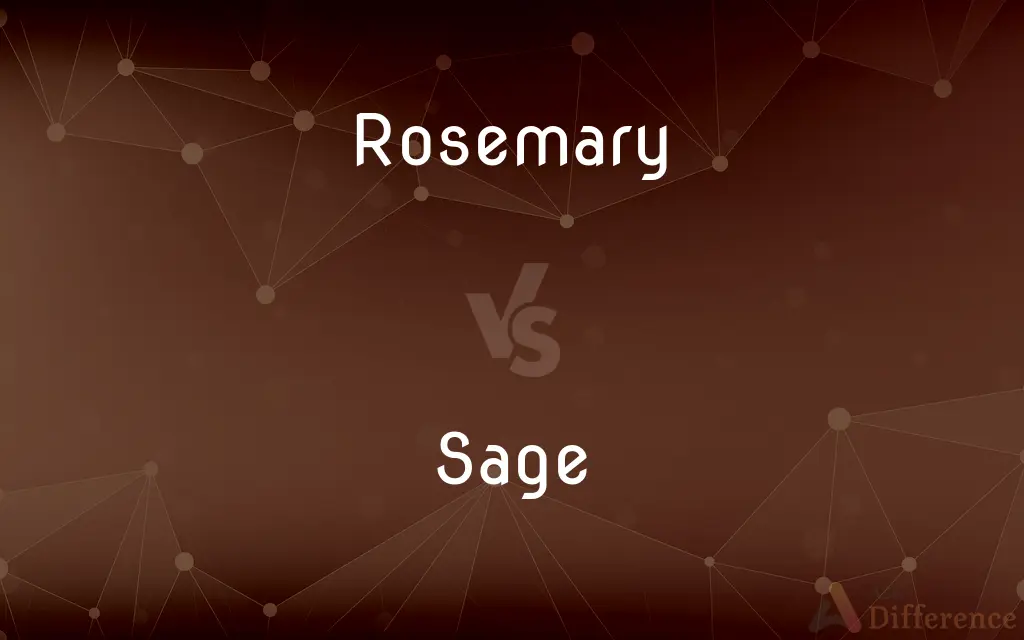Rosemary vs. Sage — What's the Difference?
By Tayyaba Rehman & Maham Liaqat — Updated on May 2, 2024
Rosemary is a fragrant herb used in culinary and medicinal practices for its strong, pine-like aroma, whereas sage is known for its earthy flavor and broad medicinal applications.

Difference Between Rosemary and Sage
Table of Contents
ADVERTISEMENT
Key Differences
Rosemary is characterized by its needle-like leaves and strong, aromatic scent, which is often associated with culinary dishes from the Mediterranean region, while sage has softer, more velvety leaves and a savory, slightly peppery flavor, making it a staple in various European cuisines.
While rosemary is often used in recipes such as roasts and stews to add a piney freshness, sage is frequently used to flavor sausages, stuffing, and infused oils, showcasing its versatility in more robust dishes.
Medicinally, rosemary is touted for its potential to improve memory, promote hair growth, and support the circulatory and nervous systems, whereas sage is recognized for its antibacterial properties, ability to ease digestion, and potential benefits in treating sore throats and maintaining oral health.
In terms of cultivation, rosemary thrives in well-drained soils and enjoys full sun, making it a suitable plant for xeriscaping. In contrast, sage requires more attention to watering and soil conditions but is equally drought-resistant once established.
Culturally, both herbs have significant historical uses; rosemary is traditionally associated with remembrance and has been used in wedding ceremonies, while sage has been used in cleansing rituals and has a sacred status in many Native American societies.
ADVERTISEMENT
Comparison Chart
Flavor Profile
Strong, pine-like, aromatic
Earthy, savory, slightly peppery
Common Uses
Roasts, stews, Mediterranean cuisine
Sausages, stuffing, teas, European cuisine
Medicinal Benefits
Memory improvement, circulatory support
Antibacterial, digestive aid, oral health
Leaf Appearance
Needle-like, stiff
Soft, velvety, broader
Cultural Significance
Symbol of remembrance, used in weddings
Used in cleansing rituals, sacred in many cultures
Compare with Definitions
Rosemary
Known for its needle-like leaves and woody aroma.
Fresh rosemary can really elevate a simple roast.
Sage
Valued for its strong, earthy flavor, ideal in heavy dishes.
I use sage extensively when preparing Thanksgiving turkey.
Rosemary
An evergreen aromatic herb of the mint family.
Rosemary thrives in my garden throughout the year.
Sage
Attracts pollinators like bees when flowering.
The flowering sage in my garden is always buzzing with bees.
Rosemary
Cultivated as a decorative plant for its attractive flowers.
The rosemary plant blooms with small, blue flowers.
Sage
A perennial, evergreen herb with grayish leaves and purplish flowers.
Sage is a common sight in herb gardens.
Rosemary
Used symbolically for remembrance.
Rosemary was worn at ANZAC Day ceremonies to honor the fallen.
Sage
Has antibacterial and digestive properties.
Sage tea is recommended for soothing sore throats.
Rosemary
Applied in traditional medicine for various ailments.
Herbal tea with rosemary is used to alleviate headache.
Sage
Used in spiritual practices for cleansing.
Burning sage is a part of many traditional cleansing ceremonies.
Rosemary
Salvia rosmarinus, commonly known as rosemary, is a shrub with fragrant, evergreen, needle-like leaves and white, pink, purple, or blue flowers, native to the Mediterranean region. Until 2017, it was known by the scientific name Rosmarinus officinalis, now a synonym.
Sage
One venerated for experience, judgment, and wisdom.
Rosemary
An aromatic evergreen Mediterranean shrub (Rosmarinus officinalis) in the mint family, having light blue or pink flowers and narrow grayish-green leaves that are used in cooking and perfumery.
Sage
Any of various plants of the genus Salvia of the mint family, especially S. officinalis, having aromatic grayish-green leaves.
Rosemary
The leaves of this plant used as a seasoning.
Sage
The leaves of S. officinalis used as a seasoning.
Rosemary
A shrub, Salvia rosmarinus (formerly Rosmarinus officinalis), that originates from Europe and Asia Minor and produces a fragrant herb used in cooking and perfumes.
Sage
Any of various similar or related plants, chiefly in the mint family.
Rosemary
A labiate shrub (Rosmarinus officinalis) with narrow grayish leaves, growing native in the southern part of France, Spain, and Italy, also in Asia Minor and in China. It has a fragrant smell, and a warm, pungent, bitterish taste. It is used in cookery, perfumery, etc., and is an emblem of fidelity or constancy.
There's rosemary, that's for remembrance.
Sage
Sagebrush.
Rosemary
Widely cultivated for its fragrant gray-green leaves used in cooking and in perfumery
Sage
Having or exhibiting wisdom and calm judgment.
Rosemary
Extremely pungent leaves used fresh or dried as seasoning for especially meats
Sage
Proceeding from or marked by wisdom and calm judgment
Sage advice.
Sage
(Archaic) Serious; solemn.
Sage
Wise.
Sage
(obsolete) grave; serious; solemn
Sage
A wise person or spiritual teacher; someone of gravity and wisdom, especially, a teacher venerable for years, and of sound judgment and prudence; a grave or stoic philosopher.
Sage
The plant Salvia officinalis and savory spice produced from it; also planted for ornamental purposes.
Sage
Any plant in the genus Salvia
Sage
Any of a number of plants such as sagebrush considered to be similar to Salvia officinalis, mostly because they are small shrubs and have gray foliage or are aromatic.
Sage
(Internet slang) Word used in the email field of imageboards to prevent a bump of the post. Used as an option rather than a word in some imageboard software.
Sage in all fields
Sage
(Internet slang) The act of using the word or option sage in the email field or a checkbox of an imageboard when posting a reply.
Reminder to sage and report.
Sage
A suffruticose labiate plant (Salvia officinalis) with grayish green foliage, much used in flavoring meats, etc. The name is often extended to the whole genus, of which many species are cultivated for ornament, as the scarlet sage, and Mexican red and blue sage.
Sage
A wise man; a man of gravity and wisdom; especially, a man venerable for years, and of sound judgment and prudence; a grave philosopher.
At his birth a star,Unseen before in heaven, proclaims him come,And guides the Eastern sages.
Sage
Having nice discernment and powers of judging; prudent; grave; sagacious.
All you sage counselors, hence!
Sage
Proceeding from wisdom; well judged; shrewd; well adapted to the purpose.
Commanders, who, cloaking their fear under show of sage advice, counseled the general to retreat.
Sage
Grave; serious; solemn.
Sage
A mentor in spiritual and philosophical topics who is renowned for profound wisdom
Sage
Aromatic fresh or dried gray-green leaves used widely as seasoning for meats and fowl and game etc
Sage
Any of various plants of the genus Salvia; a cosmopolitan herb
Sage
Having wisdom that comes with age and experience
Sage
Of the gray-green color of sage leaves
Common Curiosities
How does rosemary benefit hair growth?
Rosemary oil stimulates the scalp, promoting blood circulation and hair growth.
Can sage be used in desserts?
Yes, sage can be infused in creams and syrups, adding a subtle, earthy flavor to sweet dishes.
Is sage safe to consume daily?
Sage is safe in culinary quantities, but medicinal use should be monitored due to thujone content.
What makes rosemary unique among herbs?
Rosemary is distinctive for its strong, aromatic scent and its ability to thrive in harsh, dry environments.
How do rosemary and sage compare in their water needs?
Both are drought-resistant, but rosemary tolerates dry conditions better than sage.
How does the taste of rosemary influence its culinary use?
Its robust flavor makes it suitable for seasoning rich and hearty dishes, especially meats.
What are the ideal growing conditions for rosemary?
Rosemary prefers full sun and well-drained soil, tolerating poor, rocky conditions.
What are the traditional uses of sage in medicine?
Traditionally, sage has been used to treat digestive issues, sore throats, and memory problems.
What are sage's effects on oral health?
Sage has antibacterial properties that can support oral health by reducing bacteria and inflammation.
What culinary dishes are enhanced by rosemary?
Rosemary enhances meats, especially lamb and chicken, as well as breads and vegetables.
What role does sage play in cultural rituals?
Sage is often burned in smudging ceremonies, believed to cleanse spaces of negative energies.
What are some alternative uses for sage in the home?
Beyond cooking, sage can be used in homemade cleaning products for its antibacterial properties.
Can rosemary be used in teas?
Yes, rosemary can be brewed into a tea known to aid digestion and reduce stress.
What are some decorative uses for rosemary?
Rosemary is used in wreaths and holiday decorations for its aesthetic appeal and pleasant scent.
Can sage help with cognitive functions?
Sage is believed to have cognitive-enhancing properties, potentially improving memory and concentration.
Share Your Discovery

Previous Comparison
Lysine vs. Leucine
Next Comparison
Vignette vs. MontageAuthor Spotlight
Written by
Tayyaba RehmanTayyaba Rehman is a distinguished writer, currently serving as a primary contributor to askdifference.com. As a researcher in semantics and etymology, Tayyaba's passion for the complexity of languages and their distinctions has found a perfect home on the platform. Tayyaba delves into the intricacies of language, distinguishing between commonly confused words and phrases, thereby providing clarity for readers worldwide.
Co-written by
Maham Liaqat















































